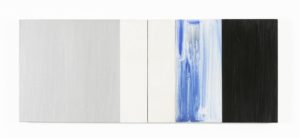
A profound interest in the location of boundaries is a constant theme in my work, whether via line, physical support, painted brush mark, or color change. The liminal draws my close attention: thresholds, rectangles, passages, apertures. My practice includes oil painting on linen, drawing and watercolor on paper or other support. The paintings pursue a dialogue between two to three rectangles of quite specific proportions, be they the given width of a material, the ratio of a cinéma screen, or the size of a chosen book.
The segmented paintings involve an errant, migratory balance of the parts. They present internal dialogues as they interlock, intersect, merge, change color, or remain silent neutral linen. The linear measurements inhabit various rectangles, and shift allegiance over the boundries of color or edge: the described rectangular shapes are in flux with no fixed sovereignity.
Although multidisciplinary may best describe the work I have been engaged with during the past ten years, I am a painter by formation ; a fluid color sensibility, a rectangle, a fabric, or a paper support are my constants.


The works on paper also focus on thesholds, with spare delineations of liminal spaces or openings : an ambiguous interval that is both entry and exit, neither inside nor outside. The watercolor and drawing works emerge from a very material interface with the physical properties of pigmented water on paper. The paper receives water in such a manner that the two become fused. Inseparable. Water transforms the mass of color into transparent ponds of color. Particles of pigment float, unified by the water, and destined to achieve the residual, matte quality implicit to paper. The colored stain is a signature imprinted within the paper which carries the memory of its liquid past.
in the essay “ Qual Quelle: les sources de Valéry”, Jacques Derrida introduces a play on a water word with [les] sources: to be understood not especially in the sense of ‘source material’, but as spring, water point or fountain and most poignantly as self….
.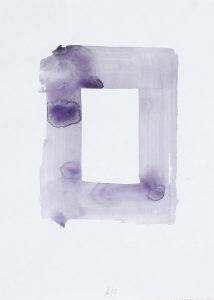
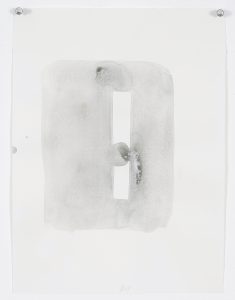
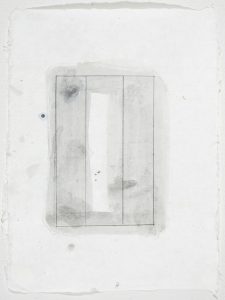
Artist books and projects:
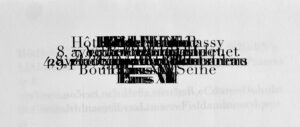
The location of boundaries, thresholds and liminal spaces, already a constant in the paintings, and drawings, reëmerged most recently with « EXILE:the Walter Benjamin projects », a multidisciplinary exploration of forms and processes.
Benjamin was in constant movement across boundaries and frontiers, both physical and intellectual ; his life and writing created a prescient literary form : errant, fragmentary, an ever modulating thought that found it’s apogee in the first half of
the 21st century. The Arcades Project, among many other works is a predominant zone of inquiry among artists, philosophers and social critics. My continuing series of work explores the parapetetic life of Benjamin through artist book and folio editions, drawings, video, collages, botanical drawings, calligraphy, installation, painted redactions, as well as a faux 1930s archive of personal effects. Study and involvement with both Benjamin’s errance and the fragmentary nature of his œuvre, permits a certain liberty, and encourages a heterogenity of forms and materiials ; and most saliently : a synthesis of words, adresses, lieux, and literature.
sources
French literature and philosophy. : Among these is the Maurice Blanchot of l’espace littéraire : an exploration of the reversibility or paradoxical relationship of the terms
le Jour et la Nuit ( the day and the night ) .
Jean- Luc Godard : the rectangle, color and montage of images and text.
A balance of movement vs statis.
James Joyce : prime for my thinking on texte and image, fluidity, and materiality of the printed word.
Walter Benjamin : whose memoirs, displacements , translations, fragments, and exile are the foundation to my work on a multiform project.